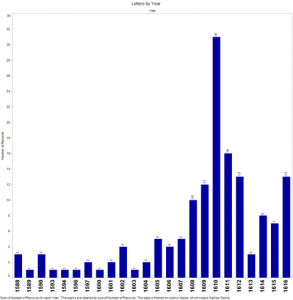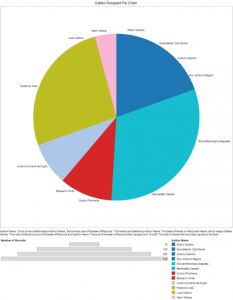The Digital Humanities project of Mapping the Republic of Letters employs several approaches such as visualization, text description and mapping to help people understand the social, physical and academic networks of certain famous scholars living before the industrial revolution. In this post, I will examine the case of Galileo Galilei.

The primary DH approach in Galileo’s case is visualization. Through the three charts on this web page, readers can easily find out the number of letters sent by Galileo per year, the range of his recipients, and the destination of his letters. Why is this information important? Let’s compare it with Galileo’s biography.
The chart on the right shows the letters which Galileo sent during 1608 to 1612 constituted more than a half of his total letters sent within 28 years. Not surprisingly, it was in 1609 that he created a telescope that could magnify objects twenty times, whereby he accomplished the discovery of the four satellites of Jupiter and sunspots, the observation of a supernova, and the verification of the phases of Venus in the following years. His discoveries proved the Copernican system, which states that the earth and other planets revolve around the sun1, and was one of his major accomplishment. It makes sense that he sent much more letters during these years to communicate with his friends about his important discoveries. And in turns, the information the chart provided demonstrates the accuracy of the time of his discoveries.

Besides providing proofs for some important intellectual work of the scholars, the Mapping the Republic of Letters project helps reader understand the scholars’ personal life better. From the pie chart below, readers might be surprised to find that Galileo had sent lots of letters to artists, which helps to locate Galileo not just in science, but within larger culture and the arts.2
Moreover, the research team employed the text description approach to facilitate the studies of Galileo’s network. It talks about the anecdote that a butcher used his letters to wrap meat, giving the readers a more comprehensive perspective of Galileo’s social status at that time.
- Extracted from http://galileo.rice.edu/bio/narrative_6.html
- Extracted from http://republicofletters.stanford.edu/casestudies/galileo.html
Comments
One response to “Analysis of Galileo’s Letters’ Republic”
Great work, Qijing!